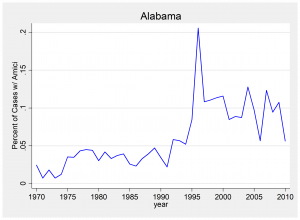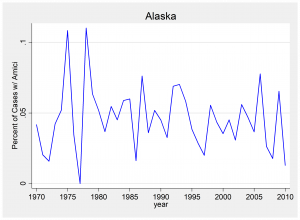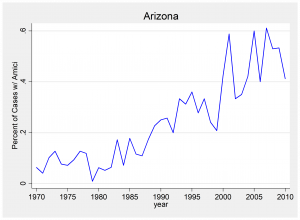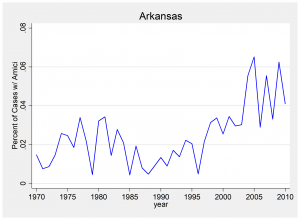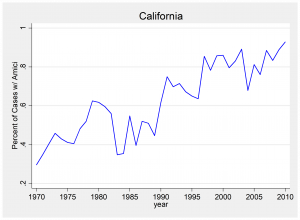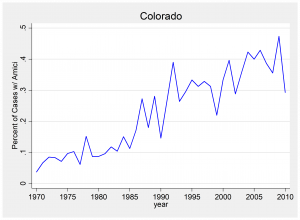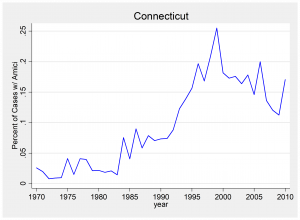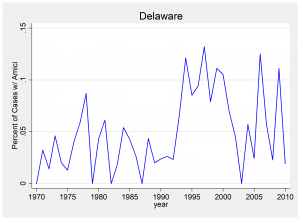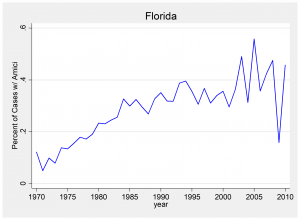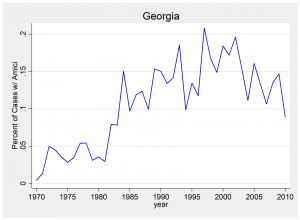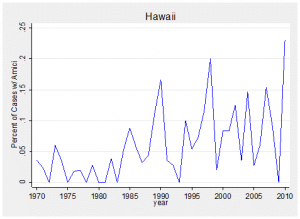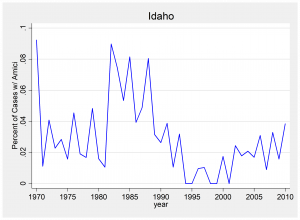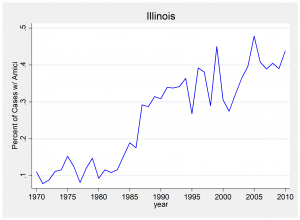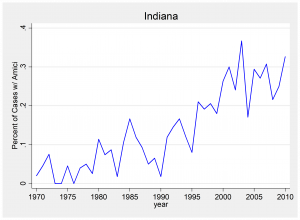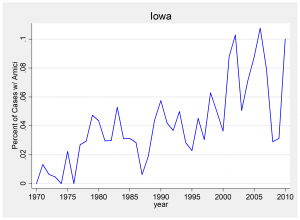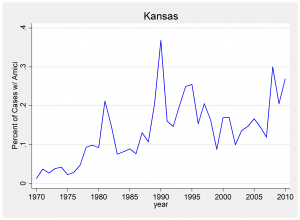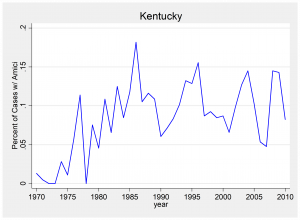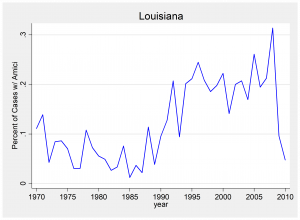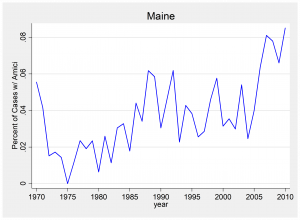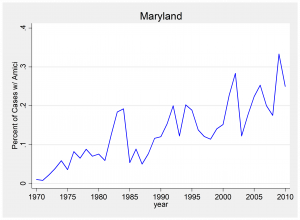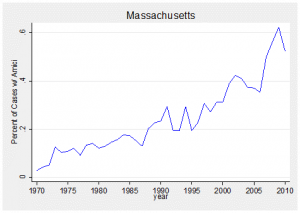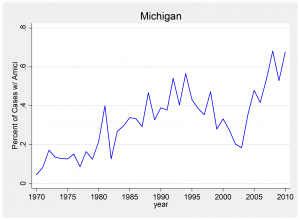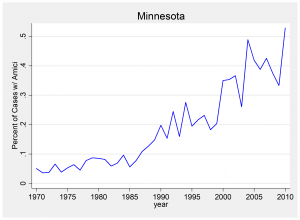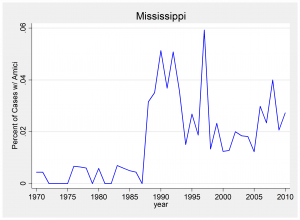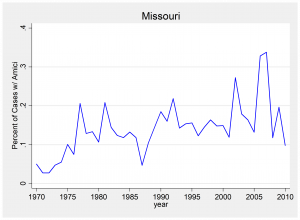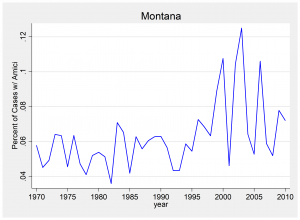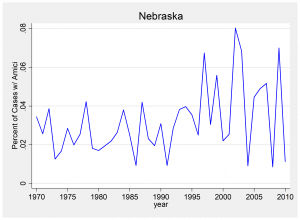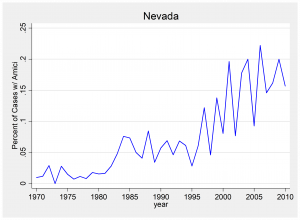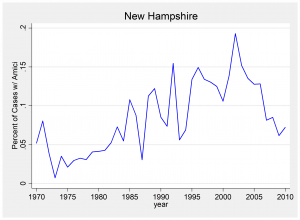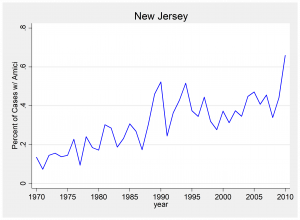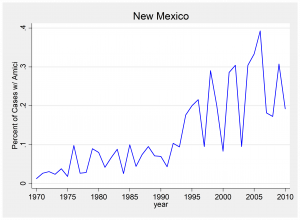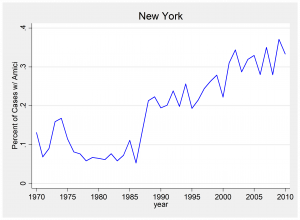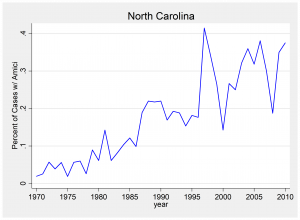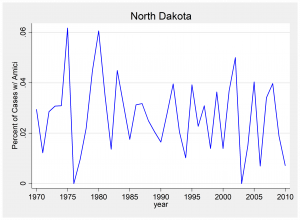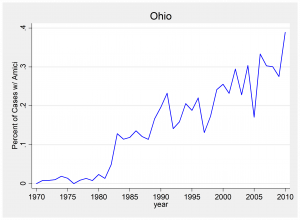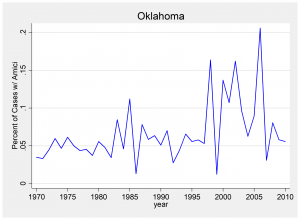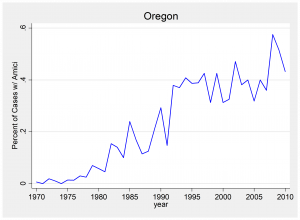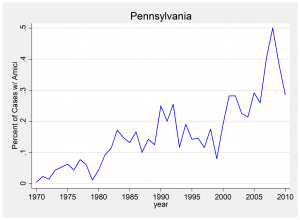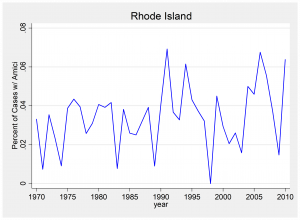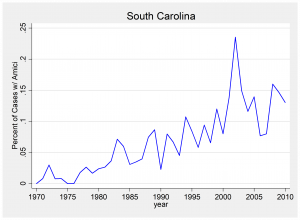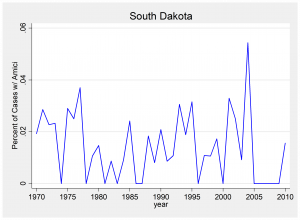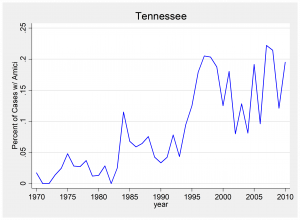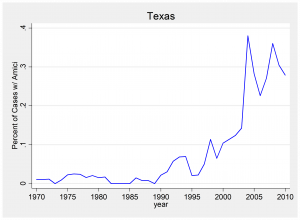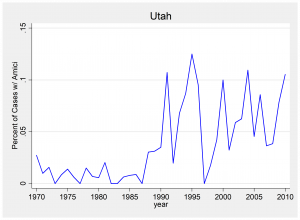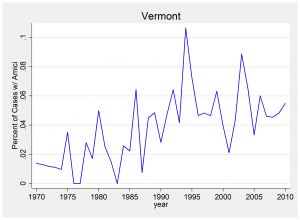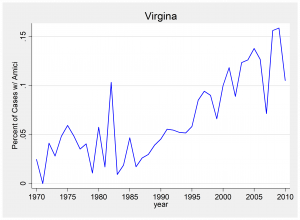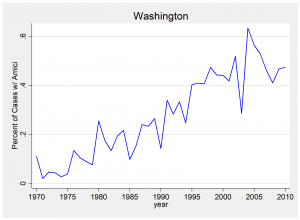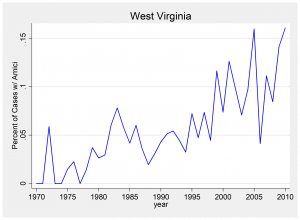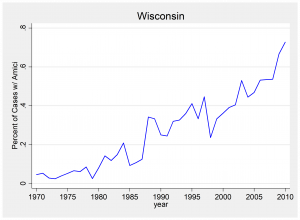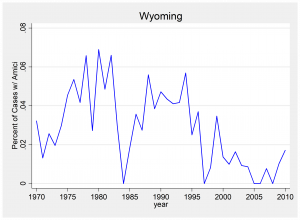Actors in the Judicial Process
14 Institutional Determinants of Amici Filings across State Supreme Courts
Jenna Becker Kane
Arthur F. Bentley recognized the propensity of organized groups to participate in the courts in order to pursue policy goals as early as 1908 (Bentley 1908). Despite this long-standing proclivity for interest groups to pursue policy objectives through the courts, lobbying the courts is very different than lobbying other branches of government (Schlozman and Tierney 1986; Truman 1951). In fact, direct lobbying tactics used to influence policy makers in other branches of government are virtually useless in the courts. Although groups often attempt to influence the courts by bringing “test” cases and sponsoring litigation on behalf of group members or individuals, groups most frequently lobby the courts through the use of amicus curiae, or “friend of the court,” briefs (Songer, Kuersten, and Kaheny 2000; Walker 1991). Because the US Supreme Court sits atop the judicial hierarchy, much scholarly attention focuses on interest group involvement as direct litigants (Epp 1998; Epstein and Kobylka 1992; Gonen 2003; Kobylka 1991; O’Connor 1980; Olson 1984; Samuels 2004; Vose 1958; 1959; Wasby 1995) and as amici curiae (Box-Steffensmeier, Christenson, and Hitt 2013; Caldeira and Wright 1998; Collins 2004, 2007, 2008, Kearney and Merrill 2000; Songer and Sheehan 1993) before the High Court. Despite the attention paid to interest group activity in the US Supreme Court, much less is known about the groups seeking to influence state supreme courts.
This lack of attention to understanding interest group involvement in state courts of last resort is surprising given the policy impact of these courts. With the US Supreme Court reviewing less than 1 percent of all cases appealed from state high courts, these courts are the final arbiters of legal, constitutional, and statutory interpretation in the states. The limited literature that investigates interest group lobbying in state high courts tends to focus on the effectiveness of groups filing amicus curiae briefs (Songer and Kuersten 1995; Songer, Kuersten, and Kaheny 2000; Kane 2017). However important these studies are, no study has yet to focus on understanding the variation in interest group participation across the states despite data that show interest group participation in state courts of last resort has increased substantially in frequency and scope (Epstein 1994).
This study seeks to explain why some states generate a more vibrant interest group population in the courts than others. Utilizing data on amicus filings in all noncriminal cases heard across the fifty state supreme courts from 1970 to 2010, this chapter explores how variations in institutional designs influence the likelihood of interest groups to engage state courts in lobbying activities. Specifically, court professionalization, method of judicial retention, and the presence of an intermediate appellate court are expected to affect the proportion of amicus filings found across state high courts. Understanding the incentives created by different state court systems allows us to understand their implications for interest group strategy in state courts.
Theory and Hypotheses
Amici, Information, and Court Professionalization
Unlike lobbying in legislative or administrative arenas, lobbying the courts through amicus curiae briefs severely limits the amount of control a group has over their advocacy campaign. Participation as amici curiae affords groups control over neither the strength of the case nor the legal framework within which their argument is presented to the courts. Despite these limitations, amici are the primary avenue through which interested third parties—typically interest groups—advocate for their preferred legal outcome in the courts. To accomplish this goal, interest groups use amicus briefs as a vehicle to provide the court with information, legal arguments, novel legal frameworks, and scientific and social scientific data and to alert the courts to the potential legal, political, and societal consequences of a case outcome (Epstein and Knight 1999; Hansford 2004). Thus the information provided in amicus curiae briefs is often theorized to be the mechanism of interest group influence in the courts (Collins 2004, 2008; Hansford 2004).
Widespread evidence exists to support this theory of informational influence. Amici are widely cited in US Supreme Court opinions (O’Connor and Epstein 1983; Spriggs and Wahlbeck 1997). Litigants with supporting amici have been found to be more likely to be successful both before the US Supreme Court (Collins 2004, 2007; Kearney and Merrill 2000; Songer and Sheehan 1993) and before state supreme courts (Kane 2017; Songer and Kuersten 1995; Songer, Kuersten, and Kaheny 2000). The value of information provided by amici is also confirmed by some US Supreme Court justices (Breyer 1998; O’Connor 1996) and by state supreme court judges and their clerks of courts (Flango, Bross, and Corbally 2006).
If groups seek to influence court decisions by offering new information in amicus briefs, they should be more likely to invest these efforts in courts that possess greater organizational capacities with which to assess and utilize amici information. In short, groups should want to file amicus briefs in courts that have the time and resources to review and give serious consideration to the arguments of amici curiae. However, there is variation across states in terms of the professionalization of state supreme courts. State high courts differ greatly in terms of judicial salary, court staffing levels, access and allocation of law clerks, and caseload demands (Squire 2008). States that allow their high courts to control their caseloads (and thus limit their workload each term), provide law clerks for their justices, and staff their courts at higher levels will be better able to digest, assess, and incorporate the views of amicus curiae briefs. Thus it is expected that states that provide their high courts with greater organizational capacities to utilize amicus information will experience higher levels of interest group participation.
Judicial Elections and Interest Groups
Differences in methods of judicial retention utilized across the states present another institutional variation that may influence interest groups’ engagement in state courts. There are five primary methods through which states retain their judges: partisan elections or nonpartisan elections, retention elections, and gubernatorial or legislative reappointment. The extant literature shows that judicial elections make state high courts more responsive to public opinion (Brace and Boyea 2008; Caldarone, Canes-Wrone, and Clark 2009; Huber and Gordon 2004). However, subjecting judges to the electoral process is often criticized for its potential to erode judicial independence by exposing judicial candidates to the rigors of campaign fundraising and advertising (Cann 2007; Sample et al. 2010; Shepherd 2009; Skaggs et al. 2011). These concerns are heightened by the increased cost of supreme court races in recent decades; the propensity for interest groups like business groups, trial lawyers associations, and unions to contribute to high court campaigns (Sample et al. 2010); and surges in outside spending by interest groups that have contributed to record-breaking spending in many recent high court campaigns (Bannon, Lisk, and Hardin 2017). In recent years, interest groups have increasingly relied on outside spending in an attempt to influence the outcome of high court races rather than contributing directly to candidate campaigns or political parties. In the 2016–17 election cycle alone, interest groups accounted for 40 percent of all outside money spent on advertising in high court races—a total of $27.8 million to elect state supreme court judges (Bannon, Lisk, and Hardin 2017, 2).
In light of the affinity for interest groups to contribute to the campaign coffers of judicial candidates, it is only logical for interest groups seeking to influence state court outcomes to focus their attention on those state high courts where there are contestable elections. A case-level analysis of amicus participation suggests this is the case; judiciaries staffed by competitive elections attracted higher rates of filings as compared to appointed and retention-elected judiciaries (Kane 2018). Therefore, states that retain their courts through contestable elections (partisan and nonpartisan elections) are expected to garner the highest level of amicus participation.
Policy Impact and State Court Structure
Interest groups may also target state high courts differently based on the perceived policy-making ability of the court. States whose court structures mimic the federal government’s three-tier model with the presence of an intermediate appellate court may attract more interest group involvement in courts of last resort than states with only general jurisdiction trial courts and state supreme courts. States with intermediate appellate courts have high court dockets that are less clogged with routine appeals. Groups seeking to participate as amicus curiae may be more likely to file briefs in states with intermediate appellate courts because high courts in these states have the ability to decide a greater number of substantive cases that impact public policy as compared to those courts whose dockets are filled largely with mandatory appeals (Squire 2008). Having fewer mandatory appeals also tends to signal lower overall caseloads for state supreme courts. Thus groups may perceive courts with smaller caseloads as having more time to consider the additional information and legal arguments contributed by third-party briefs.
Several additional independent variables are included in the analysis to control for factors that may affect interest group involvement in state supreme courts. First, because the increase in interest group involvement in state courts in the 1970s and 1980s coincided with the growing conservativism of the federal judiciary and calls by liberal groups for a rediscovery of “new judicial federalism” in which constitutional rights provisions could be secured through interpretations of state constitutions rather than the federal Constitution (Epstein 1994), a measure of state supreme court ideology is included to control for the possibility that groups are filing amicus curiae briefs in more liberal-leaning courts. State supreme court ideology is measured using Brace, Langer, and Hall’s (2000) party-adjusted judge ideology (PAJID) scores, which range from 0 to 100, with lower scores representing more conservative-leaning judges and higher scores more liberal-leaning judges. PAJID scores have been shown to outperform partisan identification as a measure of judge ideology and are available for the range of dates included in this study.
Similarly, due to the growing conservatism of the federal bench and emphasis by many groups to see more liberal interpretations of individual rights under state constitutions, the Erickson, Wright, and McIver (1993, 2006) measure of state citizen ideology is also included to control for the possibility that groups may be focusing on lobbying the courts in more liberal-leaning states. This measure of citizen ideology was created by disaggregating pooled CBS News / New York Times national polls between 1976 and 2003 to generate state-level estimates of citizen ideology. Scores range from −30.8 in Mississippi, the most conservative state, to 8 in the most liberal state of Vermont.
Another variable included in the analysis seeks to control for the possibility that interest groups are incentivized to file amicus curiae briefs in states where the groups already have an organization presence. If an interest group has existing offices within a given state, the costs of filing amicus curiae briefs should decrease, as the group’s existing resources, infrastructure, and institutional knowledge decreases the costs of lobbying. To account for this possibility, Gray and Lowry’s (1996) measure of interest group density, which assesses the number of interest organizations registered to lobby in each state, is included in the analysis.
The final control variable included is a measure of state legislative professionalism. Because many interest groups are primarily engaged in lobbying state legislatures, it may be that groups are filing amicus curiae briefs in the judiciaries of states that they have already targeted with legislative strategies. If this is the case, we may observe greater levels of interest group participation in states that have more professionalized legislatures as opposed to citizen-led legislatures. Squire’s (1992, 2007) index of legislative professionalism is a composite index of various factors including legislator salary, length of legislative session, and staffing resources. The measure ranges from 0 to 1, where an index score of 1 indicates that a state legislature perfectly mirrors the professionalism of the US Congress and a score of 0 indicates no resemblance whatsoever.
Data and Research Design
In order to generate a measure of amicus participation in state supreme courts that varies across both states and time, state-specific search queries were crafted in Westlaw to determine the percentage of cases with amicus participation in each year for each state supreme court. These state- and year-specific search queries produced data for the dependent variable—the percentage of noncriminal cases decided by state supreme courts that involved at least one amicus curiae brief. Criminal cases are excluded from the analysis because they greatly increase the number of cases heard by those state supreme courts that hear mandatory appeals in criminal cases while adding little to the overall picture of amicus participation. Across the fifty states, state high courts hear varying degrees of criminal appeals. In states without intermediate appellate courts, state high courts must review every criminal appeal generated by the lower trial courts. In other state courts of last resort, criminal appeals are only mandatory for certain classes of felony cases or in cases involving death-eligible offenses. If criminal appeals were included in the measure of the dependent variable, it could bias the overall proportion of cases with amicus participation in a downward direction for certain states, potentially masking the amount of interest group involvement in state high courts that hear mandatory appeals. Conversely, because amicus participation in state criminal appeals is infrequent, there is little reason to believe that excluding criminal cases from the measure of amici participation will drastically alter the picture of interest group participation in the states.
In order to gather data on the participation rates of amici across the states, a two-stage Westlaw search was conducted for each state over a forty-year period. The first search identified all noncriminal cases decided with full written opinions in each state while eliminating slip decisions, unpublished decisions, orders, and certiorari decisions that also appear in the Westlaw state databases. The second stage of the search was used to limit the initial search to include only those cases in which the words amici or amicus appear. Once the cases with amici were identified, each case was examined to be sure there was at least one amicus brief filed and that the search terms amicus and amici were not identifying a reference to an amicus brief in the body of the court’s decision. In most instances, state-specific search criteria were required in order to identify all noncriminal cases decided with full opinions.
The model below is used to estimate the influence of the independent variables on the proportion of noncriminal cases in state supreme courts that include amici between 1970 and 2004.
All of the hypothesized relationships between independent variables and the amount of amicus participation are premised on the institutional variation across states. While the data utilized in this study vary both over time and across states—time-series cross-sectional data—most of the independent variables of interest are slow or nonmoving over the time period examined. For example, only eight states altered their method of judicial retention over the forty-year span. Because there is little variation over time in most variables, two models will be estimated, both of which allow for the inclusion of time-invariant variables. First, an ordinary least squares (OLS) regression model with clustered standard errors is utilized with year-fixed effects in order to account for any year-specific effects that might be present. This model will allow all variables to be included while accounting for the possibility that observations within states may be correlated or associated with one another. Second, because many of the hypotheses predict amicus participation rates to differ due to variations of high court institutional design across states, a between-effects model is estimated to explain the amount of variation of amicus filings that is accounted for only by the variation of the independent variables between states.
Trends in Amicus Participation
Figure 1 depicts a snapshot of amicus participation across all fifty states in 2010. By examining the most recent year included in the data set, we are able to obtain a sense of the overall participation rates of interest groups in state high courts. Overall, interest groups filed amicus curiae briefs in 23.1 percent of all civil cases filed in state supreme courts in 2010. However, there is great variation around this mean value of amicus activity. The California Supreme Court had the highest amici participation rate at 92.9 percent. Wisconsin’s highest court had the second-largest amici participation rate with 72.7 percent. Michigan and New Jersey saw amici activity at 67.6 percent and 65.9 percent, respectively, while the supreme courts of Minnesota and Massachusetts attracted amici in nearly 53 percent of civil cases for that year. Despite these high rates of interest group participation in some state high courts, many states saw little amicus participation at all. North Dakota’s highest court saw virtually no activity in 2010 with an amicus participation rate of 0.7 percent, and the state supreme courts of Nebraska, Alaska, South Dakota, Wyoming, and Delaware all saw amicus filings in fewer than 2 percent of civil cases.
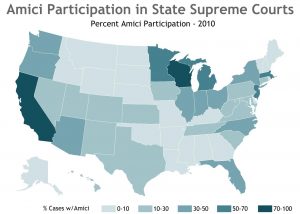
Figure 2 shows the percentage of change in amicus participation rates in each state between 1970 and 2010. Overall, amicus participation in the states has increased over the past four decades. However, this increase has not occurred simultaneously in all states. While California saw a steady increase in interest group involvement in the high courts—ranging from a low of 30 percent in the early 1970s to nearly 93 percent in 2010—other states saw little to no increase in amicus filings. Most notably, Arkansas, Idaho, Iowa, Maine, Mississippi, Montana, Nebraska, North Dakota, Rhode Island, South Dakota, Utah, Vermont, and Wyoming all saw amicus participation rates that fluctuated below 1 percent over the majority of the forty-year period. Figure 3 shows a more detailed examination of amicus participation rates in each state over the full time frame. Results of the multivariate analysis lend some insight into why interest groups are prominent players in some state high courts and virtually nonexistent in others.
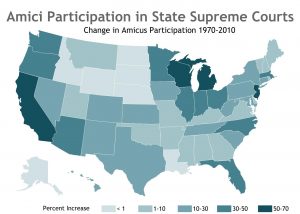
Figure 3. Amicus Participation Rates across Time in the U.S. States
Results
Most hypotheses are confirmed by the results of the multivariate models, as shown in table 1. The single largest effect on amicus participation rates in a state’s high court is the level of court professionalization. The more professionalized a state supreme court, the greater the amici participation. In substantive terms, a state high court that is one standard deviation above the mean value of court professionalization, such as the Supreme Court of South Carolina, would have an amicus participation rate that is 5.7 percentage points higher than the Oklahoma Supreme Court, with a professionalization score that is approximately one standard deviation below the mean. The Michigan Supreme Court, which has a professionalization score that is two standard deviations above the mean, will witness amicus filing rates that are 11.4 percentage points greater than those witnessed in the North Dakota Supreme Court, which falls two standard deviations below the mean. These results suggest that states with more professionalized high courts are more attractive lobbying venues for interest groups. It appears that interest groups are aware of the level of staffing and resources possessed by state supreme courts and are targeting more professionalized courts that are better positioned to process and incorporate amici information into their judicial decision-making.
| OLS Model w/ Clustered Robust SEs w/ Year FEs | Between Effects OLS Model | |
|---|---|---|
| State Supreme Court Professionalization Contestably Elected Court |
0.197*
(0.091) 0.081* (0.027) |
0.159*
(0.081) 0.074* (0.033) |
| Retention Elected Court | 0.080*
(0.032) |
0.064
(0.035) |
| intermediate Appellate Court | 0.017
(0.024) |
0.037
(0.032) |
| Court Ideology | -0.0002
(0.0003) |
-0.001
(0.001) |
| Interest Group Density | -0.00001
(0.00001) |
-0.00001
(0.00001) |
| Legislative Professionalization | 0.336**
(0.094) |
0.0331*
(0.136) |
| State Ideology | 0.005*
(0.001) |
0.005*
(0.002) |
| Constant | -0.139*
(0.057) |
0.003
(0.061) |
| R2 | 0.568 | 0.679 (between) |
| N | 1740 | 1740/50 groups |
Table 1: Predicting Percent of Cases with Amicus Participation in a State
*p<0.05, **p<0.001
Results of both models show that the method of judicial retention is also significantly and positively related to interest group participation in state high courts, as originally hypothesized. Specifically, states that utilize contestable elections, both partisan and nonpartisan, to retain high court judges attract third-party briefs at rates between 7.4 and 8.1 percent higher than states that appoint high court judges. States that use retention elections to retain high court judges also appear to have amicus filing rates that are 8.0 percent higher when compared to states that utilize reappointive methods. It should be noted, however, that the results of retention elections fall just short of statistical significance in the between-effects model, though its coefficient is in the expected positive direction. The fact that interest groups are targeting elected judiciaries suggests that groups believe that courts accountable to the electorate may be more easily influenced by the views of outside interests. It is also interesting to note that, counter to expectations, interest groups also appear to be consistently targeting retention-elected courts. While retention elections are often designed to engender judicial independence and decrease public accountability, it appears that organized interests see these courts as more amenable to the views of third-party groups.
Surprisingly, states with intermediate appellate courts do not see greater levels of amicus filings when compared to those states without. In fact, a state that has an intermediate appellate court is no more likely to have greater amicus activity than a state without an intermediate appellate court. This suggests that third-party groups are not specifically targeting state high courts that have greater discretion over their caseloads.
Some of the control variables showed the expected relationships to the dependent variable. Legislative professionalism and state ideology are both positively associated with amicus participation rates in the states. States with more professionalized legislatures promote higher levels of amicus participation than do states with less-professionalized or citizen legislatures. These results may be a product of interest group familiarity with lobbying in the legislative arenas. Groups that regularly lobby more professionalized state legislatures appear to be more willing to enter the judicial arena by lobbying the high courts of those same states. Interest groups are also filing more amici in liberal-leaning states. This may be a result of the growing conservatism in the federal judiciary since the 1960s that propelled many liberal-leaning interest groups to seek greater rights protections in the states. Or perhaps organized groups, both liberal and conservative alike, believe that courts in more liberal-leaning states will be more amenable to the concerns of outside interests. While these explanations cannot be fully tested in this chapter, they leave open avenues for future research.
Contrary to expectations, state supreme court ideology proves to have no significant effect on the amicus participation rate in any of the models. This finding is particularly interesting when considered in conjunction with the positive and statistically significant effects of state ideology on amicus participation. Interest groups are not targeting amicus filings in states with more liberal judiciaries but do appear to be targeting courts in more liberal-leaning states. Perhaps state ideology is more visible to interest groups than the ideology of state high courts, and thus interest groups gauge the receptivity of courts to amicus arguments by the overall ideology of the state. Also surprisingly, the level of interest group density in a state does not have the predicted positive effect on amicus participation. This suggests that state high courts are not being targeted by groups solely because a given state has a particularly active interest group community.
Conclusions
With the relatively few cases being decided each year by the US Supreme Court, state high courts are routinely the final arbiters on most matters of state and federal law. With the policy-making power of these courts long entrenched, it is no surprise that interest groups have taken an interest in lobbying state high courts. This study provides the first comprehensive examination of the trends of interest group activity in state high courts from 1970 to 2010. The results indicate that interest group involvement in state high courts has proliferated in recent decades. However, this growth in amicus filings appears to have occurred unevenly, with some states showing steady increases and others showing erratic patterns of amicus filings over time. Utilizing original data on amicus filings in all noncriminal cases decided by state supreme courts, this study also finds that institutional variations in state court design account for much of the observed variation in amicus participation. Specifically, high court professionalization and contestable elections all serve to increase the rate by which amicus curiae briefs are filed in state high courts.
Results of this study indicate that interest groups view courts with greater access to resources and staff and more docket control as better arenas for presenting their policy expertise. This should not be surprising given the unique nature of lobbying courts. Groups filing amicus curiae briefs often must fit their policy arguments in the legal framework and fact patterns of an existing legal dispute. This affords groups less control over the design of their advocacy efforts than is typical in the legislative or administrative arenas. Given these limitations, the results of this analysis suggest that groups are strategically targeting more professionalized high courts that possess the resources to better equip a court to utilize and evaluate the information provided in third-party briefs.
States with popularly elected judiciaries also prove to be attractive venues for amicus participation by organized interests. Whether states hold contestable elections or use retention elections, interest groups filing amicus curiae appear to be attracted to courts whose judges are publicly accountable. The same elected courts that are often targeted by organized interests in third-party attack advertising during judicial elections are also more likely to be targeted by organized interests filing amicus curiae. Groups seem to be seizing on the electoral connection of these courts in hopes of increasing their chances of litigation success. Whether this affinity to filing amicus curiae in publicly accountable judiciaries is tied to the democratic nature of these courts or the perception that the demands of campaign fundraising erode judicial independence enough to open these elected courts to outside influences, organized interests are targeting elected judiciaries—both contestable and retention-elected judiciaries—at higher rates than their appointed counterparts.
As strategic actors, the study finds that interest groups target state high courts that they believe will be more amenable to the concerns of third-party and state high courts that have the institutional capacity to make use of the information provided in these briefs. Groups are also targeting courts in more liberal-leaning states and those with more professionalized legislatures. While this type of strategic behavior by interest groups with limited resources may not be overly surprising, it does have implications for the independence of state judiciaries. If judicial elections are designed to create a democratic link between citizens and courts, this link may be eroded if the realities of running for office make these courts more susceptible to the policy arguments of interest groups filing amicus curiae. While the impact of these amicus briefs on state high court decision-making is beyond the scope of this analysis, there definitely appears to be a propensity of organized groups to target publicly accountable courts.
References
Bentley, Arthur F. 1908. The Process of Government: A Study of Social Pressures. Chicago: University of Chicago Press. (↵ Return)
Bannon, Alicia, Cathleen Lisk, and Peter Hardin. 2017. Who Pays for Judicial Races? The Politics of Judicial Elections 2015–16. New York: Brennan Center for Justice. (↵ Return 1) (↵ Return 2)
Box-Steffensmeier, Janet M., Dino P. Christenson, and Matthew P. Hitt. 2013. “Quality Over Quantity: Amici Influence and Judicial Decision Making.” American Political Science Review 107 (3): 446–460. (↵ Return)
Brace, Paul, and Brent D. Boyea. 2008. “State Public Opinion, the Death Penalty, and the Practice of Electing Judges.” American Journal of Political Science 52 (2): 360–372. (↵ Return)
Brace, Paul, Laura Langer and Melinda Gann Hall. 2000. “Measuring the Preferences of State Supreme Court Judges.” Journal of Politics 62 (2): 387–413. (↵ Return)
Breyer, Stephen. 1998. “The Interdependence of Science and Law.” Judicature 82 (1): 24–27. (↵ Return)
Caldarone, Richard P., Brandice Canes-Wrone and Tom Clark. 2009. “Partisan Labels and Democratic Accountability: An Analysis of State Supreme Court Abortion Decisions.” Journal of Politics 71 (2): 560–573. (↵ Return)
Caldeira, Gregory A., and John R. Wright. 1998. “Lobbying for Justice: Organized Interests, Supreme Court Nominations, and the United States Senate.” American Journal of Political Science 42 (2): 499–523. (↵ Return)
Cann, Damon. 2007. “Justice for Sale? Campaign Contributions and Judicial Decisionmaking.” State Politics & Policy Quarterly 7 (3): 281–297. (↵ Return)
Collins, Paul M. 2004. “Friends of the Court: Examining the Influence of Amicus Curiae Participation in U.S. Supreme Court Litigation.” Law & Society Review 38 (4): 807–832. (↵ Return 1) (↵ Return 2) (↵ Return 3)
Collins, Paul M. 2007. “Lobbyists before the U.S. Supreme Court: Investigating the Influence of Amicus Curiae Briefs.” Political Research Quarterly 60 (1): 55–70. (↵ Return 1) (↵ Return 2)
Collins, Paul M. 2008. Friends of the Supreme Court: Interest Groups and Judicial Decision Making. New York: Oxford University Press. (↵ Return 1) (↵ Return 2)
Epp, Charles R. 1998. The Rights Revolution: Lawyers, Activists, and Supreme Courts in Comparative Perspective. Chicago: University of Chicago Press. (↵ Return)
Epstein, Lee, and Jack Knight. 1999. “Mapping Out the Strategic Terrain: The Informational Role of Amici Curiae.” in Supreme Court Decision-Making. ed. Cornell W. Clayton and Howard Gillman. Chicago: University of Chicago Press. (↵ Return)
Epstein, Lee, and Joseph F. Kobylka. 1992. The Supreme Court and Legal Change: Abortion and the Death Penalty. Chapel Hill: The University of North Carolina Press. (↵ Return)
Epstein, Lee. 1994. “Exploring the Participation of Organized Interests in State Court Litigation.” Political Research Quarterly 47 (2): 335–351. (↵ Return 1) (↵ Return 2)
Erickson, Robert S., Gerald C. Wright and John P. McIver. 1993. Statehouse Democracy: Public Opinion and Policy in the American States. New York: Cambridge University Press. (↵ Return)
Erickson, Robert S., Gerald C. Wright and John P. McIver. 2006. “Public Opinion in the States: A Quarter Century of Change and Stability.” In Public Opinion in State Politics, ed. Jeffrey E. Cohen. Stanford: Stanford University Press. (↵ Return)
Flango, Victor E., Donald C. Bross, and Sarah Corbally. 2006. “Amicus Curiae Briefs: The Court’s Perspective” Justice System Journal 27 (2): 180–190. (↵ Return)
Gonen, Julianna S. 2003. Litigation as Lobbying: Reproductive Hazards and Interest Aggregation. Columbus: Ohio State University Press. (↵ Return)
Gray, Virginia, and David Lowery. 1996. The Population Ecology of Interest Representation: Lobbying Communities in the American States. Ann Arbor: University of Michigan Press. (↵ Return)
Hansford, Thomas G. 2004. “Information Provision, Organizational Constraints, and the Decision to Submit an Amicus Curiae Brief in a U.S. Supreme Court Case.” Political Research Quarterly 57 (2): 219–230. (↵ Return 1) (↵ Return 2)
Huber, Gregory A., and Sanford C. Gordon. 2004. “Accountability and Coercion: Is Justice Blind when It Runs for Office?” American Journal of Political Science 48 (2): 247–263. (↵ Return)
Kane, Jenna Becker. 2017. “Lobbying Justice(s)? Exploring the Nature of Amici in State Supreme Court Decision Making.” State Politics & Policy Quarterly 17 (3). (↵ Return 1) (↵ Return 2)
Kane, Jenna Becker. 2018. “Informational Need, Institutional Capacity, and Court Receptivity: Interest Groups and Amicus Curiae in State High Courts.” Political Research Quarterly 71 (4): 881–894. (↵ Return)
Kearney, Joseph D., and Thomas W. Merrill. 2000. “The Influence of Amicus Curiae Briefs on the Supreme Court.” University of Pennsylvania Law Review 148:1–68. (↵ Return 1) (↵ Return 2)
Kobylka, Joseph F. 1991. The Politics of Obscenity: Group Litigation in a Time of Legal Change. New York: Greenwood Press. (↵ Return)
O’Connor, Karen. 1980. Women’s Organizations’ Use of the Courts. Lexington, MA: Lexington Books. (↵ Return)
O’Connor, Karen, and Lee Epstein. 1983. “The Rise of Conservative Interest Group Litigation.” Journal of Politics 45 (2): 479–489. (↵ Return)
O’Connor, Sandra Day. 1996. “Henry Clay and the Supreme Court.” Speech Delivered to the Henry Clay Memorial Foundation October 4. Available http://www.henryclay.org/sc.htm (inactive link as of 5/21/2020) (↵ Return)
Olson, Susan M. 1984. Clients and Lawyers: Securing the Rights of Disabled Persons. Westport: Greenwood Press. (↵ Return)
Sample, James, Adam Skaggs, Jonathan Blitzer and Linda Casey. 2010. “The New Politics of Judicial Elections, 2000–2009: Decade of Change.” Washington, DC: Justice at Stake Campaign. (↵ Return 1) (↵ Return 2)
Samuels, Suzanne U. 2004. First Among Friends: Interest Groups, the U.S. Supreme Court, and the Right to Privacy. Westport: Praeger. (↵ Return)
Schlozman, Kay Leman, and John T. Tierney. 1986. Organized Interests and American Democracy. New York: Harper & Row Publishers. (↵ Return)
Shepherd, Joanna M. 2009. “Money, Politics, and Impartial Justice.” Duke Law Journal 58:622–685. (↵ Return)
Skaggs, Adam, Maria da Silva, Linda Casey and Charles Hall. 2011. “The New Politics of Judicial Elections, 2009–2010.” Washington, DC: Justice at Stake Campaign. (↵ Return)
Songer, Donald R., and Ashlyn Kuersten. 1995. “The Success of Amici in State Supreme Courts.” Political Research Quarterly 48: 31–42. (↵ Return 1) (↵ Return 2)
Songer, Donald, Ashlyn Kuersten and Erin Kaheny. 2000. “Why the Haves Don’t Always Come Out Ahead: Repeat Players Meet Amici Curiae for the Disadvantaged.” Political Research Quarterly 53 (3): 537–556. (↵ Return 1) (↵ Return 2) (↵ Return 3)
Songer, Donald R., and Reginald S. Sheehan. 1993. “Interest Group Success in the Courts: Amicus Participation in the Supreme Court.” Political Research Quarterly 46 (2): 339–354. (↵ Return 1) (↵ Return 2)
Spriggs, James F. and Paul J. Wahlbeck. 1997. “Amicus Curiae and the Role of Information at the Supreme Court.” Political Research Quarterly 50 (2): 365–386. (↵ Return)
Squire, Peverill. 1992. “Legislative Professionalization and Membership Diversity in State Legislatures.” Legislative Studies Quarterly 17 (1): 69–79. (↵ Return)
Squire, Peverill. 2007. “Measuring State Legislative Professionalism: The Squire Index Revisited.” State Politics & Policy Quarterly 7 (2): 211–227. (↵ Return)
Squire, Peverill. 2008. “Measuring the Professionalization of U.S. State Courts of Last Resort.” State Politics & Policy Quarterly 8 (3): 223–238. (↵ Return 1) (↵ Return 2)
Truman, David B. 1951. The Governmental Process: Political Interests and Public Opinion. New York: Knopf Press. (↵ Return)
Vose, Clement E. 1958. “Litigation as a Form of Pressure Group Activity.” The Annals of the American Academy of Political and Social Science 319:20–31. (↵ Return)
Vose, Clement E. 1959. Caucasians Only: The Supreme Court, the NAACP, and the Restrictive Covenant Cases. Berkeley: University of California Press. (↵ Return)
Walker, Jack L. Jr. 1991. Mobilizing Interest Groups in America: Patrons, Professions, and Social Movements. Ann Arbor: University of Michigan Press. (↵ Return)
Wasby, Stephen L. 1995. Race Relations in an Age of Complexity. Charlottesville: University of Virginia Press. (↵ Return)
Class Activity
Guidelines for Instructors
Break students into groups and have them work together to locate and skim an amicus brief submitted to a state supreme court. Briefs are typically available through Westlaw or LexisNexis Academic subscriptions held by many university libraries. Having students locate the briefs is also a good way for them to try a bit of legal research for themselves. However, instructors could also distribute preprinted briefs to the groups if locating them is too time-consuming. If your university library does not have access to a searchable legal database, full-text versions of these briefs filed with the US Supreme Court are available at SCOTUSblog (www.scotusblog.com) and could be used to hold the same discussion with students.
Below are a few case citations from the data set used in this article that contain good full-text amicus briefs filed in state supreme courts. These cases cover products liability, the environment, and free speech, and each was selected because there are multiple amici filed by various groups. This gives the instructor the ability to have each group examine different amicus briefs stemming from the same legal dispute.
Products Liability Cases
- Advincula v. United Blood Services (1996) 678 N.E.2d 1009.
- Johnson v. American Standard, Inc. (2008) 179 P.3d 905. https://caselaw.findlaw.com/ca-supreme-court/1309537.html
- Kitchen v. K-Mart Corp. (1997) 697 So.2d 1200. https://caselaw.findlaw.com/fl-supreme-court/1254858.html
Environmental Cases
- Clean Wisconsin, Inc. v. Public Service Com’n of Wisconsin (2005) 700 N.W.2d 768.
- Eagle Environmental II, L.P. v. PA Dept. of Environmental Protection (2005) 884 A.2d 867
- Fafard v. Conservation Com’n of Barnstable (2000) 733 N.E.2d 66
Free Speech/Expression Cases
- Bowman v. Heller (1995) 651 N.E.2d 369
- Tuite v. Corbitt (2006) 866 N.E.2d 114
- Tyne v. Time Warner Entertainment Co., L.P. (2005) 901 So.2d 802
Discussion Questions
- What types of arguments are the groups making to the court?
- Do you find the group’s argument credible? Why or why not?
- What about the arguments submitted by the amici would be helpful to a state supreme court (or courts more broadly)?
- Should courts consider outside arguments other than the legal arguments submitted by the litigants involved in the case? Why or why not?
- Should courts be responsive to interest groups filing amicus curiae briefs? Why or why not?
- Does responsiveness to interest groups undermine judicial independence?
- This chapter determines that groups appeared to be targeting elected courts more often than appointed courts.
- Why do you think groups might target elected courts?
- Is this targeting of elected courts by interest groups problematic? Why or why not?

